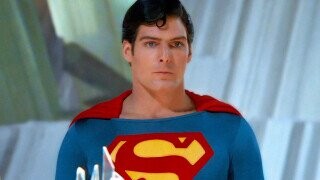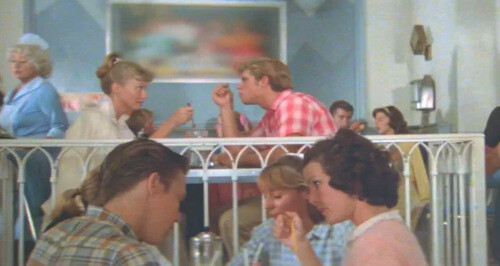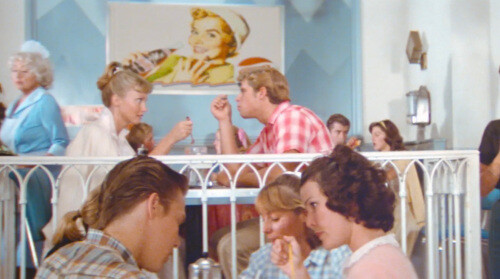5 Little Things Movies And Shows Did (That PO'd Advertisers Big Time)

As evidenced by the career of Adam Sandler and any movie that contains the words “Michael” and/or “Bay” in the credits, Hollywood films are basically just giant commercials; Willy Wonka and the Chocolate Factory was made to sell candy, Stranger Things is practically one big Eggo waffle spot, and Avatar was clearly bankrolled by Big Unobtanium. Sometimes, though these lucrative pop-culture branding opportunities don’t work out so well for these attention-seeking companies, such as how …
Grease Used VFX To Obscure Coca-Cola Ads (And Keep Pepsi Happy)
Featuring John Travolta, the late Olivia Newton-John, and a bunch of other grown-ass adults creepily masquerading as high schoolers, Grease is the classic movie about rock and roll, romance, and sacrificing your entire identity in order to please some dirtbag who seemingly has some issues when it comes to consent.
In order to secure their status as the official beverage of musical perverts, Pepsi struck a deal with producer Alan Carr to have their products featured in the movie. Unfortunately, no one mentioned this to the prop manager, who “screwed up” and placed a Coca-Cola poster in the film’s Frosty Palace diner. Carr reportedly “blew a gasket when he saw the scene after production wrapped.” And rather than have two brown sugar waters featured in the movie, the decision was made to remove the offending ad using cutting edge technology a big blurry blob that looked like absolute crap.

Paramount
Yeah, since visual effects were somewhat limited at the time, rather than reshoot the scene, the producer just blurred out the poster as if it was the face of someone being shoved into a squad car on COPS. Apparently this awkward workaround annoyed both director Randal Kleiser and Grease fans, so much so that it was altered for the film’s 40th anniversary DVD release. No, they didn’t simply remove the blur, but used digital technology to insert a new image of someone enjoying a delicious bottle of Pepsi.

Paramount
In retrospect, maybe we should be glad that George Lucas never thought to insert billboards for Taco Bell on the exterior of the Death Star.
Marlboro Bought Creative Control Of Superman II (Possibly So Clark Kent Wouldn’t Lecture Lois Lane About Smoking)
Superman never seemed to be pro-smoking, exactly – not just because we never see him light one up after a hard day of fighting crime and perilously reversing the orbit of the Earth, but in the ‘80s we literally saw him beat up (and seemingly murder) a petty thug named Nick O’Teen for simply offering children a complimentary cigarette.
And in the 1978 Superman movie, the Man of Steel warns habitual Marlboro consumer Lois Lane about the dangers of smoking – and even uses his X-ray vision to screen her for lung cancer.
Which could possibly be why the sequel received a major influx of cash from Marlboro’s parent company Philip Morris – hence why one scene in Superman II features Supes battling General Zod in the back of a goddamn Marlboro truck.
Putting ads for cigarettes in a family-friendly fantasy movie is bad enough, but reportedly the “roughly $40,000” Marlboro spent also got them a certain degree of creative control over the story itself, giving Philip Morris “absolute discretion as to the final content of the Film.” And the agreement even included a separate clause ensuring that no part of the movie would be “detrimental” to the “Marlboro brand name.”
Which, in retrospect, is hard not to interpret as a pretty intense reaction to the 2 ½ seconds of anti-smoking content in the first movie. And this wasn’t without controversy at the time, health advocates noted that “Marlboro cigarettes are seen at least 22 times in Superman II.” Although, given the amount of creative control they had, it’s a wonder that we didn’t get a scene revealing that the effects of Kryptonite could be cured by smoking a pack of menthol lights.
Black And Decker Sued Fox Over John McClane’s Lack Of Power Tools In Die Hard 2
Action hero (and Jesus’ number one Christmastime rival) John McClane is no stranger to selling out, lest we forget the time he battled a squad of deadly armed goons purely to obtain some DieHard brand car batteries – instead of, say, reading a magazine while waiting for AAA to arrive. But long before that, McClane was going to shill for another product available at your local hardware store …
Originally, Die Hard 2 was going to feature a scene in which McClane removes “an air-duct grill in an airport tunnel with a Black & Decker cordless drill” – presumably because, following the events of the first Die Hard, McClane just carried a drill with him at all times in case he chose to travel by air-duct. According to the power tool company, they became “promotional partners” with the production, heavily banking on their inclusion in the sequel to the point where they arranged an ad campaign for the drill “built around the movie.”
Unfortunately, the scene was cut from the finished film, which Black & Decker only found out about three days before its release, prompting them to sue the studio for the “loss of credibility.” The lesson here is that if any brand wanted to sponsor a Die Hard movie, it really should have been a shoe company.
Natural Born Killers Featured A Coke Commercial … Intercut With Images Of Dead Bodies
When you think of “Oliver Stone” and “Coke,” you probably think of … well, this:
But in Natural Born Killers, Stone worked with the soda company of the same name, who was apparently totally cool and not at all suspicious that the Platoon guy wanted to use one of their commercials in his ultra-violent satire about a cross-country killing spree. Reportedly, Coca-Cola lent out one of their classic Polar bear commercials to the film, believing that it would be used in a scene in which “Tommy Lee Jones watched the Super Bowl on television.”
But instead, the Coke commercials were employed multiple times throughout the movie, including in scenes depicting violence, sexual assault, and “interspersed with images such as a headless, bloody body.” At the time, Coca-Cola stated that they were: “concerned that our commercial is being used in a way we didn’t intend and weren’t aware of.” And Stone claimed that the company was “furious” when they saw the movie.
Sex And The City Was Just The Beginning Of Peloton’s Problems
As we’ve mentioned before, the recent Sex and the City reboot, And Just Like That …, begins with Carrie’s husband, Mr. Big, dying of a heart attack, thanks to a ride on his Peloton bicycle – and also, arguably, Carrie’s own incompetence. This had some major consequences; the company’s stock dropped 11% overnight following the episode – presumably because most Americans believe that their TV is a magical portal into another universe, not a device which transmits works of scripted fiction.
While Peloton knew that their product would be used in the show, according to a company rep: “HBO did not disclose the broader context surrounding the scene to Peloton in advance.” So they were understandably shocked when their product was used, not for a pre-cosmo workout, but as a veritable “murder weapon.”
Somehow things got even worse for Peloton after the episode aired. For starters, they tried to spin the newfound notoriety to their advantage by hiring actor Chris Noth (who played Big) to star in a tongue-in-cheek, primed-to-go-viral commercial for Peloton, underscoring the health benefits of their product.
But what should have been a slam dunk PR move immediately blew up in everybody’s faces when two women accused Noth of sexual assault, forcing Peloton to yank the commercial out of circulation less than a week later. If that wasn’t bad enough for the company, the next month, yet another high-profile cable series, Billions, featured yet another character suffering a heart attack after a ride on a Peloton – although in this case, the character survived, quipping: “I’m not going out like Mr. Big.”
Needless to say, Peloton wasn’t exactly thrilled with their new image as prestige TV’s Angel of Death.
You (yes, you) should follow JM on Twitter!
Thumbnail: Warner Bros.
